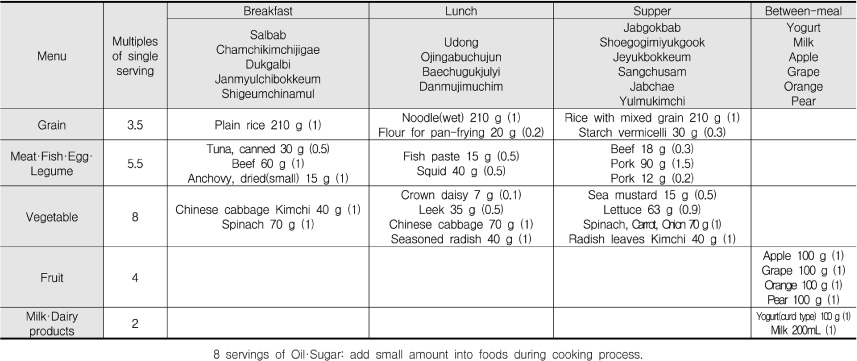Korean J Community Nutr.
2017 Aug;22(4):279-288. 10.5720/kjcn.2017.22.4.279.
Nutritional Adequacy Analysis of Recommended Menu in Dietary Reference Intakes for Koreans 2015
- Affiliations
-
- 1Department of Home Economics Education, Korea National University of Education, Cheongju, Korea. youngnam@knue.ac.kr
- KMID: 2389564
- DOI: http://doi.org/10.5720/kjcn.2017.22.4.279
Abstract
OBJECTIVES
Recommended Menu (RM) prepared according to the Target Pattern expected to meet the dietary reference intake (DRI) of nutrients. Nutritional adequacy of RM in "˜DRI for Koreans 2015' were analyzed to verify whether such expectation was fulfilled.
METHODS
Dishes in RM are categorized by 5 food groups, and number and types of dishes for main meal and between-meals were analyzed. The energy and 12 nutrients (protein, dietary fiber, Ca, P, Fe, Na, K, vitamin A, thiamin, riboflavin, niacin and vitamin C) contents in 10 RMs were calculated using the food composition table (CD) in "˜DRI for Koreans'. Energy, energy contribution ratio, and nutrient contents in 10 RMs for 18 age groups were evaluated based on the "˜DRI for Koreans 2015'.
RESULTS
Number of dishes per meal were 4.83, and representative table setting consisted of cooked rice + soup (or stew) +3 side dishes. Energy contents of RM were 75~109% of estimated energy requirement (EER). None of the RM met the DRI of all 12 nutrients examined. Calcium was the most insufficient nutrient. Only 1-2 years' RM met the DRI, all the other RMs did not meet the calcium DRI. Dietary fiber and potassium contents were also insufficient in most RM. In adult male's RM, only 1 nutrient, i.e. calcium did not meet the DRI, but in female adult's RM, 5~6 nutrients did not meet the DRI. Energy contribution ratio of carbohydrate, protein, and fat in RM were 59.0~70.4%, 15.7~17.5%, 12.1~23.5%, respectively. And 4 RMs out of 10 exceeded the upper limit of acceptable macro-nutrient distribution range (AMDR) of carbohydrate and 3 RMs out of 10 RM were below the lower limit of fat AMDR. Contribution ratio of nutrients were ≥ 40% by food groups were as follows: grain group in energy and carbohydrate; meat·fish·egg·legume group in fat, protein, and niacin; vegetables group in dietary fiber, vitamin A, and vitamin C; milk·dairy products group in calcium.
CONCLUSIONS
RM prepared according to the Target Pattern did not meet nutritional adequacy as expected. Especially calcium, potassium, and dietary fiber contents are needed to be increased in many RMs. Further, energy content in RM needs to be adjusted for fat·sugar food group assigned in Target Pattern and condiment.
MeSH Terms
Figure
Reference
-
1. Ministry of Health and Welfare. Korea Centers for Disease Control and Prevention. Korea health statistics 2015: Korea National Health and Nutrition Examination Survey (KNHANES VI-3) [Internet]. 2016. cited 2017 Jun 28. Available from: https://knhanes.cdc.go.kr/knhanes/sub04/sub04_03.do?classType=7.2. National Research Council. Recommended dietary allowances. 10th ed. Washington, DC: National Academy Press;1989. p. 1–2.3. Ministry of Health and Welfare. The Korean Nutrition Society. Ministry of Food and Drug Safety. Dietary reference intakes for Koreans. 1st revision. Seoul: The Korean Nutrition Society;2010. p. 524–535.4. Ministry of Health and Welfare. The Korean Nutrition Society. Dietary reference intakes for Koreans 2015. Sejong: Ministry of Health and Welfare;2015. p. vi–xii. p. 433p. 944–976.5. Kim AR, Kim MJ, Kim Y. Nutritional assessment of menu plan prepared according to the target pattern: Menu prepared by home economics teachers and middle-school girls. Korean J Community Nutr. 2011; 16(3):375–385.6. Lee HY, Kim Y. Revision and application of the Target Pattern in Food Guidance System: Administered to 2nd grade middle school students. Korean J Community Nutr. 2014; 19(3):274–282.7. Park MJ, Kim Y. Revision of the Target Pattern based on single serving size of dishes for Korean adolescent meal plan. Korean J Community Nutr. 2015; 20(1):21–29.8. Park MJ, Kim Y. Proposition and application of a dish-based Target Pattern for Korean adolescent girls. Korean J Community Nutr. 2015; 20(2):87–95.9. Kim JO, Kim Y. Assessment of menu plan prepared by middle school students according to ordinary meal pattern and single serving size. Korean J Community Nutr. 2013; 18(4):333–343.10. The Korean Nutrition Society. Food composition table CD in dietary reference intakes for Koreans. Seoul: The Korean Nutrition Society;2005.11. The Korean Nutrition Society. Food values of portions commonly used. Seoul: The Korean Nutrition Society;1998. p. 47. p. 171. p. 199. p. 233. p. 279.12. The Korean Nutrition Society. Dietary reference intakes for Koreans. Seoul: The Korean Nutrition Society;2005. p. 331–355.13. Kim MH, Yang KM, Yoon JM, Yoon TJ, Lee BH, Lee YS, et al. New clinical nutrition. Paju: Gigumunwhasa;2012. p. 190.
- Full Text Links
- Actions
-
Cited
- CITED
-
- Close
- Share
- Similar articles
-
- Recommended Intake and Dietary Intake of Vitamin A for Koreans by Unit of Retinol Activity Equivalent
- Effect of School Lunch Menu Intervention through Calcium Enriched Menus on Nutrient Intakes of High School Girls
- The development of the 2020 Dietary Reference Intakes for Koreans: carbohydrate
- Choline intake and its dietary reference values in Korea and other countries: a review
- Folate: 2020 Dietary reference intakes and nutritional status of Koreans


